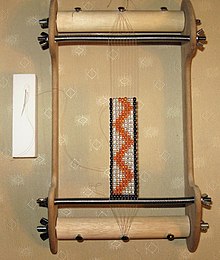Bead weaving
Bead weaving (or beadweaving) using seed beads can be done either on a loom or using one of a number of off-loom stitches.
On-loom beadweaving[edit]
When weaving on a loom, the beads are locked in between the warp threads by the weft threads. The most common bead weaving technique requires two passes of the weft thread. First, an entire row of beads is strung on the weft thread. Then the beads are pressed in between the warp threads. The needle is passed back through the beads above the warp threads to lock the beads into place. Heddle looms were popular near the beginning of the 20th century. They allowed weaving of beads by raising every other thread and inserting strung beads in the shed, the space between the lowered and raised threads. There are still a few Heddle Bead Looms being manufactured today. The most difficult part of loomwork is finishing off the warp threads.
Although loomed pieces are typically rectangular, it is possible to increase and decrease to produce angular or curvy shapes. Fringe can also be added during weaving or before the piece is removed from the loom.
Bead looms vary in size and are typically made of wood or metal. Usually, a comb or spring is used to hold the warp threads a bead-width apart. Some looms have roller bars that allow the weaver to produce pieces that are longer than the loom. Most looms are meant to sit on a table, but some have floor stands or are meant to sit in the lap.
Off-loom beadweaving[edit]

Off-loom beadweaving is a family of beadwork techniques in which seed beads are woven together into a flat fabric, a tubular rope, or a three-dimensional object such as a ball, clasp, box, or a piece of jewelry. All off-loom techniques can be accomplished using a single needle and thread (no warp threads), but some have two-needle variations. Different stitches produce pieces with distinct textures, shapes, and patterns. There are many different off-loom bead stitches, including new stitches (distinct thread paths) published only in 2015:
- albion stitch, developed by Heather Kingsley-Heath, published May 2009[1]
- brick stitch, also known as Comanche or Cheyenne stitch
- chevron stitch, a triangular form of bead netting[2]
- diamond weave, developed over a number of years by Gerlinde Lenz, published August 2015[3]
- herringbone stitch, also known as Ndebele stitch
- hubble stitch, developed over a number of years by Melanie de Miguel [4][5]
- netting, to avoid confusion specifically bead netting
- peyote stitch, also known as gourd stitch
- pondo stitch, also known as African circle stitch
- right-angle weave
- Saint Petersburg chain
- square stitch, an off loom stitch that mimics the look of loomed bead projects.
- ladder stitch, a foundation stitch that is used to build a base for brick stitch or herringbone stitch.
- triangle weave
Spiral Bead Weaving Stitches
- Cellini spiral, a tubular peyote stitch[6]
- Dutch spiral
- African helix
- Russian spiral
- Chenille
References[edit]
- ^ Kingsley-Heath, Heather (2009). Albion Stitch: An Introduction to the New Beadwork Stitch. Useful Booklet Company. ISBN 0954367278.
- ^ Wells, Carol Wilcox (2003). The Art & Elegance of Beadweaving. USA: Lark Books. pp. 54–64. ISBN 978-1-57990-533-0.
- ^ Thomas, Cath; Lenz, Gerlinde (2015). Diamond Weave: A complete guide to mastering the bead world's newest stitch. CreateSpace Independent Publishing Platform. ISBN 978-1-5147-3715-6.
- ^ de Miguel, Melanie (2015). Let's Hubble: A Journey into the Brand New Beadwork Stitch. SRA Books. ISBN 978-1-909116-47-4.
- ^ de Miquel, Melanie. "Hubble Stitch". Beadwork. Oct/Nov 2015.
- ^ Gerlach, Julia, ed. (2005). Best of Bead&Button magazine : peyote stitch beading projects. Waukesha, Wis.: Kalmbach Pub. pp. 46–47. ISBN 0-87116-218-0.
Further reading[edit]
- Virginia Blakelock, Those Bad, Bad Beads! Virginia Blakelock Publisher, 1990.
- Don Pierce, Beading on a Loom. Interweave Press, 1999. ISBN 1-883010-63-2
- Carol Wilcox Wells, Creative Bead Weaving. Lark Books, 1996. ISBN 1-887374-05-1



No comments:
Post a Comment